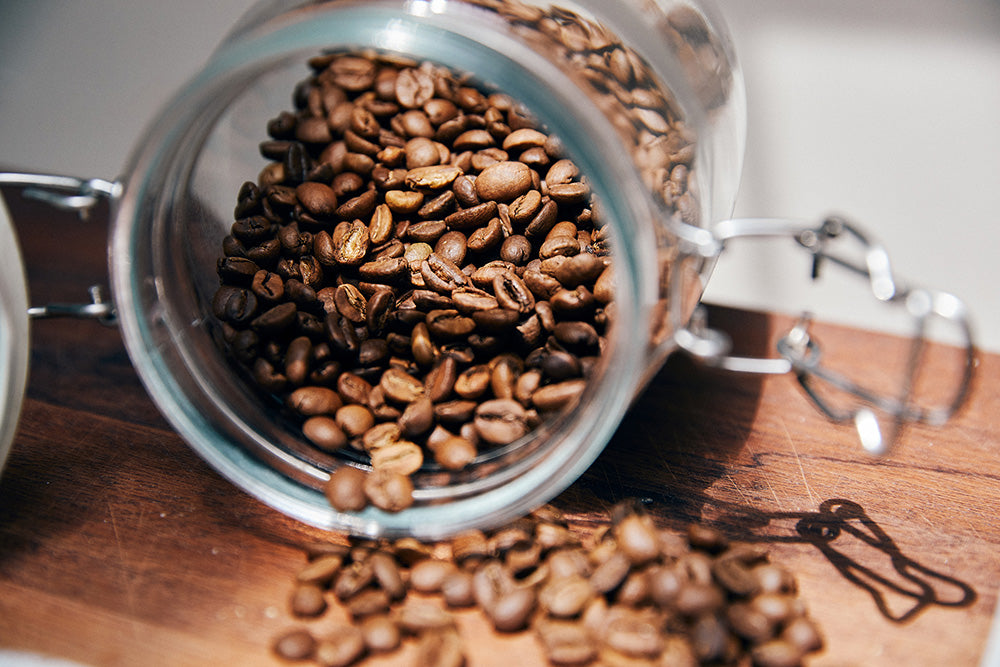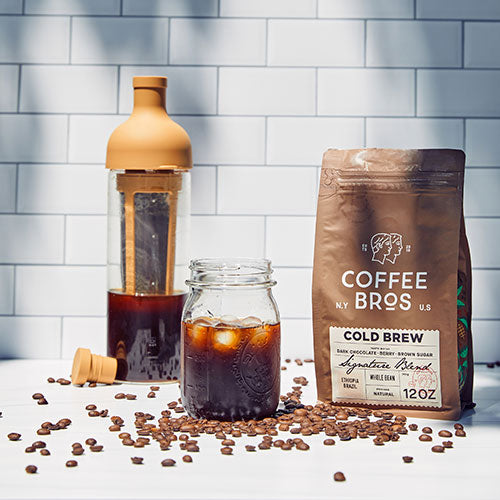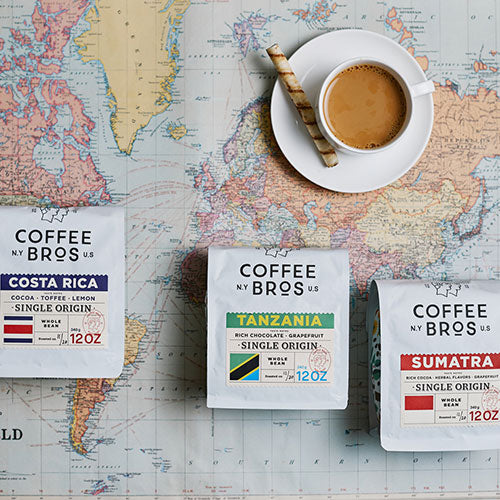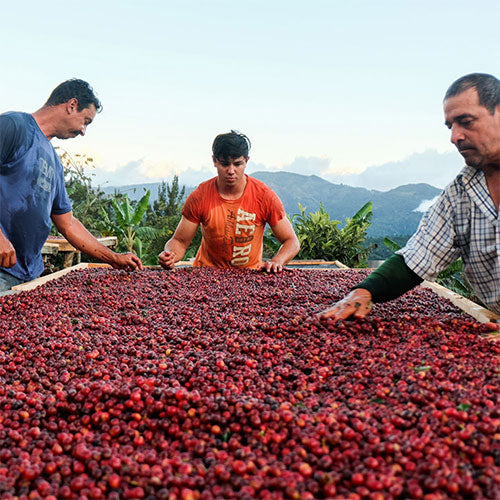Light Roast vs. Dark Roast Coffee: All Differences Explained
Introduction
The distinction between light-roasted and dark-roasted coffee is not as straightforward as it may appear. While color is often the first attribute that comes to mind, it is important to consider how the roast level and development affects the taste, optimal brewing techniques, brewing temperatures, caffeine levels, crema production in espresso, and more. In this article, we aim to explore the various differences between these two roast styles, provide insight into the best brewing methods for each, and help you determine which type of roast may be best suited for your personal preferences.
Light Roast vs. Dark Roast: Table of Contents
- What is Light Roasted Coffee
- What is Dark Roasted Coffee
- Taste Difference Between Light Roast and Dark Roast Coffee
- Best Brewing Method for Light Roasted and Dark Roasted Coffee
- Best Brewing Temperatures for Light Roasted and Dark Roasted Coffee
- Caffeine Difference Between Light Roast and Dark Roast
- How to Brew Light Roasted Espresso
- How to Brew Dark Roasted Espresso
Light Roast Coffee Definition
All coffee is based on preference from taste all the way down to what color you deem as light, medium, or dark roasted coffee. We define light roasted coffee not only by the color, but how far along in the roasting development process we take a coffee. We also "cup" or sample our coffees to ensure they are hitting on certain flavor profiles to hit on that "light roast" flavor. All-in-all, color is a great initial determining factor for what is considered light but the ultimate test comes down to roast development and taste.
Here is an example of a lightly roasted coffee displayed using Cropster (software roasters use to track a coffees roast development and temperature during the roasting process).
Dark Roast Coffee Definition
Dark-roasted coffee is defined not only by its dark appearance but also by how "developed" the coffee is. Coffee goes through several stages during the roasting process, from drying, Maillard, caramelization, and carbonization. Dark-roasted coffee pushes beyond the third stage of development and into carbonization, picking up those classic dark-roasted notes; deep chocolate, smoky, and roasty.
Here is an example of a dark roasted coffee displayed using Cropster (software roasters use to track a coffees roast development and temperature during the roasting process).
Taste Difference Between Light Roast and Dark Roast Coffee
Have you seen the Coffee Taster’s Flavor Wheel? It is one of the tools coffee roasters use to help describe their coffees to consumers. We will use many of these notes when describing the differences between light roast coffees and darker roasted coffees.
We think the best way to describe the differences is by breaking down the two coffee roast types across flavor, aroma, and body.
Before we start, here are some quick definitions that may be helpful:
Aroma refers to the smell of coffee, which plays a significant role in its flavor. Over 800 different aromatic compounds have been identified in coffee and the aroma can range from light and fruity to burnt. Fresh coffee has a stronger aroma compared to stale coffee, and the aroma of the coffee can become stronger as the roast gets darker.
Flavor is the defining characteristic of coffee, and it's a combination of taste and aroma that originates in the mouth and extends to the nose. When evaluating the flavor of coffee, the score should reflect the strength, quality, and complexity of the combined taste and aroma.
Body refers to the mouthfeel of the coffee, which contributes significantly to its overall quality. Coffees with a heavy body tend to have high preference ratings, while those with a lighter body can still be pleasing.
| Taste Descriptors | Light Roast | Dark Roast |
|
Aroma |
Floral, fruity, sweet |
Roasty, smoky, burnt |
|
Flavor |
Florals, berries, citrus, sour |
Nutty, cocoa, cooked fruit, caramelized |
|
Body |
Light, thin |
Bold, heavy, thick |
Light-roasted coffee tends to be bright, clean, sour, acidic, and sometimes tea-like. Also, depending on the processing method of the coffee itself, certain flavors are underlying attributes may shine through more. Naturally processed light-roasted coffees tend to be sourer and sweeter than washed coffees. Washed coffees and known to be floral and bright, while they can also be acidic, they tend to be much cleaner and consistent tasting (consistent in taste from the front of the palette to the back).
Darker-roasted coffees are bolder and pick up heavier caramelized and smoky notes from the additional development in the roaster. Darker-roasted coffees work great in milk as their heavier body and boldness help cut through the fat of the milk and allow the underlying coffee taste to shine through.
Best Brewing Method for Light Roast and Dark Roast Coffees
Best brewing method for Light Roasted Coffees:
The optimal way to brew Light Roasted Coffee is through the pour-over method using tools such as a v60 or Fellow's Stagg brewer. This method provides the barista with a significant level of control, allowing them to extract the coffee's full flavor profile. The three crucial elements of brewing the perfect cup are time, temperature, and water-to-coffee ratio, all of which can be precisely controlled through a manual pour-over.
In our experience, pour-overs bring out the most flavor from the coffee and are particularly effective when brewing Light Roasted Coffees. These coffees are meant to be consumed black, which is why we appreciate the precision and control of the pour-over method in extracting their flavor.
We have a fondness for Light Roasted Coffees brewed as espresso, which are typically bright, acidic, and sweet. Adding milk to a light roast espresso is an option, but it is important to note that the coffee flavor will be lost in anything above a 1:1 ratio (40g espresso to 40g milk).
Best brewing method for Dark Roasted Coffees:
Dark-roasted coffee offers numerous brewing options, but the key to making it taste great is the grind size and temperature. If the grind size is too fine, the coffee can quickly taste bitter or burnt. To avoid this, make sure to adjust your grind size to be slightly coarser than you would for a light roast.
The intended presentation of the coffee by the roaster also has a significant impact on how well it will work with different brewing methods. While any coffee can be brewed in any manner, it is always best to start with the method that the roaster intended, whether it be espresso or filter brew.
We recommend starting with a pour-over to fully understand the coffee's complex flavor notes and then moving on to your preferred brewing method or one recommended by the roaster.
When brewing a medium to dark-roasted coffee for pour-over and seeking a bolder taste, aim for a 1:12 to 1:14 ratio. Using grams, this would mean using 25 to 28 grams of coffee for every 340 grams (12 ounces) of water.
Last but not least, dark-roasted coffees work exceptionally well in milk-based drinks. If you are an avid-coffee drinker who prefers milk in their drinks, we suggest leaning toward a medium to dark roasted coffee.
Best Brewing Temperatures for Light Roast to Dark Roasted Coffees
The general rule of thumb here is that lighter roasts do better and show higher cup quality when brewed at temperatures close to or at boiling point.
As the coffee roast gets darker, you will start to notice a decline in cup quality at higher temperatures and it is recommended to brew darker roasts cooler. Brewing darker roasts at cooler temperatures also tend to combat bitterness and highlight more of the sweetness in the cup than when brewing at hotter temperatures.
When it comes to the recommendations below, test different brewing temperatures using the same grind sizes for each roast type. You might find a few degrees of difference in one direction, or the other makes a huge difference in your cup’s quality, clarity, and aromatics.
| Roast Type | Optimal Brewing Temperature (Fahrenheit) | Optimal Brewing Temperature (Celsius) |
|
Light Roast |
199 - 205 |
93 - 96 |
|
Medium Roast |
194 - 200 |
90 - 93 |
|
Dark Roast |
188 - 194 |
87 - 90 |
When it comes to brewing dark roast espresso, we have brewed as cool as 85 degrees Celsius with some very interesting results. We are fortunate enough to have access to an espresso machine where you can temperature profile meaning that you can start the brewing process at one temperature and have it slowly decline during brewing. We found darker roasts do exceptionally well at 88 degrees Celsius at the start of the brew and slowly decline its temperature throughout. This method brought out a ton of sweetness eliminated any bitterness and maintained the coffee’s round body.
Caffeine Difference Between Light Roast and Dark Roasted Coffee
The misconception that darker roasted coffees or lighter roasted coffees contain more caffeine comes down to an inadequate measurement of coffee and a bit of hearsay.
Do you know anyone that measures coffee in “scoops,” well this inadequate measurement device creates large discrepancies in total coffee weight between light-roasted coffee and dark-roasted coffee? Due to the vast difference in the weight of the coffee beans between light and dark roast, one “scoop” of light-roasted coffee beans will weigh significantly more than a “scoop” of dark-roasted coffee.
During the roasting process, the further developed or higher temperature coffee is roasted, the more water weight it loses. Have you ever bought a 12-ounce bag of light roast and said to yourself, no way is this actually 12 ounces! Well, those light-roasted coffee beans are dense than dark-roasted coffee and you need a lot less when brewing due to their heavier weight.
If we were to compare light-roasted coffee vs dark-roasted coffee using the ancient “scoop” method, light-roasted coffee will always have more caffeine than dark-roasted coffee due to its weight differences.
Others may think that the harshness or bitterness associated with a dark roast is a function of strength with caffeine levels. That again is not true, and the taste of coffee has little or nothing to do with how much caffeine it contains.
That said, when looking at different coffee varietals, Arabica coffee does have less caffeine than Robusta and the Robusta varietal is often used in darker roasted coffees.
How to Brew Light Roasted Espresso
We love Light Roasted Coffees as espresso but know they will be very bright, acidic, and sweet. You can certainly add milk to a lightly roasted espresso drink, but the coffee will get lost in anything above a 1:1 ratio (40g espresso shot to 40g of milk).
There are a few ways of approaching a light-roasted coffee as an espresso.
- Brew the light roast as a “lungo” which can range from a 1:3 and 1:4 ratio of espresso grounds to brew liquid. Try a light roasted espresso with 20 grams of ground coffee to 60 grams of liquid for a cleaner cup with high clarity.
- Brew your light roast at a higher temperature ranging from 93 – 96 degrees Celsius. Brewing your light roast at higher temperatures will also improve cup quality, and aromatics, and help combat the natural acidity of a lightly roasted coffee. You can certainly try brewing a lightly roasted coffee as a “normale” but we still prefer a “lungo” shot.
- When adding milk to your light-roasted espresso, keep your espresso-to-milk ratio no higher than 1:1 as light-roasted coffees get easily lost in milk.
How to Brew Dark Roasted Espresso
The key to a delicious dark-roasted espresso is all about temperature. Try brewing your dark roast at cooler temperatures ranging from 87 – 90 degrees Celsius and even cooler if your machine has the capability of doing so.
Dark roasted coffees can quickly become harsh and astringent when brewing at “normal” or higher temperatures which is why we suggest brewing at lower temperatures.
Further, darker-roasted coffees make phenomenal milk-based beverages like lattes and cappuccinos. If you are looking for an espresso roast that works well with milk, lean toward medium to darker roasted coffees.




